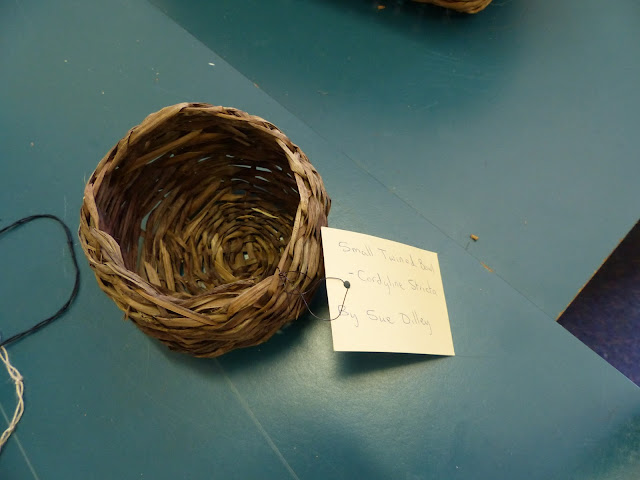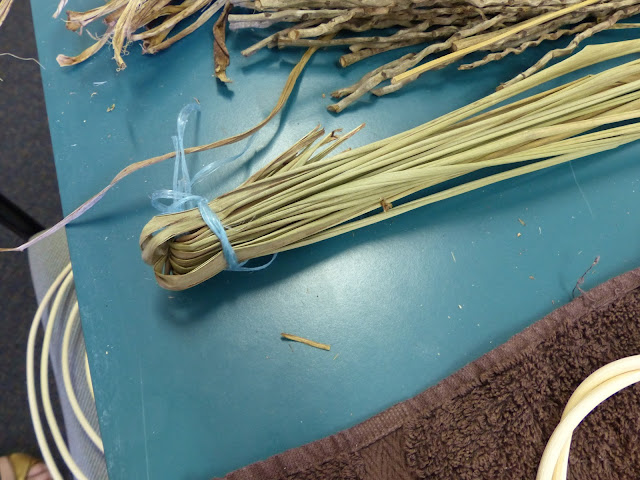Sue took us through a wonderful display of different baskets made from native and exotic plant fibres.
She explained how to select and dry the plant material and gave us plenty of tips:
- Drying should be done in the shade
- If you don't plan to use your dried plant material immediately, then it should be stored wrapped up in butcher's paper to keep it clean and dry, and with the paper labelled to identify contents.
- Vines - to be suitable for basketmaking they must be able to wrap around your finger 3 times without breaking
- Leaves should be generally be collected after the plant has flowered and then dried.
- Grasses - to dry these, spread them on newspaper and each day move the grass around so it dries completely
Spinifex - Here's a basket Sue made from spinifex grass using a darning needle and cotton thread:
Watsonia - a weed in many areas, this can be collected when it dries on the plant. It has a lovely chestnut colour.
Cordyline - Cordyline australis is a tough fibre and can be collected as it drops off the plant. However if you pull it off when fresh the leaves will be in better shape (no stringy bits to them). Cordyline stricta is a lighter fibre than australis, but still good for basketmaking. Here's a basket Sue made from stricta:
Red Hot Poker(Kniphofia)- these should be collected green, after the plant has flowered
Bullrush - collect in January by cutting as low in the water as you can. Strip off the leaves and collect at the tip of the stalk, fold it over, tie and hang up to dry. You can see an example of how to tie the stalks in the picture below
Passionfruit vine - this can be used fresh or it can be coiled up until ready to use when it will need to be rehydrated slightly. Rehydration may take a couple of days if the vine is thick.
Here's a picture of a basket Sue made from passionfruit vine:
Fruit tree prunings are also a great basketmaking fibre. Sue had several examples of baskets she'd made from fruit tree prunings.
The basket below was made from apple prunings:
And this basket was made from olive prunings:
As an unexpected bonus, we all got to have a go at basket-making in the form of a small tension tray. As the name suggests, it is the tension between the branches that holds the tray together. Here's a tension tray Sue made from black willow:
Sue had kindly already cut and pre-soaked the cane for us to use. A quick demonstration and we jumped in and had a go.
Here's mine in progress:
And the finished product:
The whole experience was a lot of fun and we were very fortunate to have an expert such as Sue who was kind enough to give up her time to spend with us.
To finish this post I have to show you my favourite of all the baskets, one made from fallen Jacaranda leaf stalks. Isn't it gorgeous?
If you are interested in basketmaking, you should definitely check out the Basketmakers of Victoria website. They run a lot of events and classes where you can learn to make your own beautiful baskets.



















Beautiful work, I have trouble sharpening a pencil.
ReplyDelete